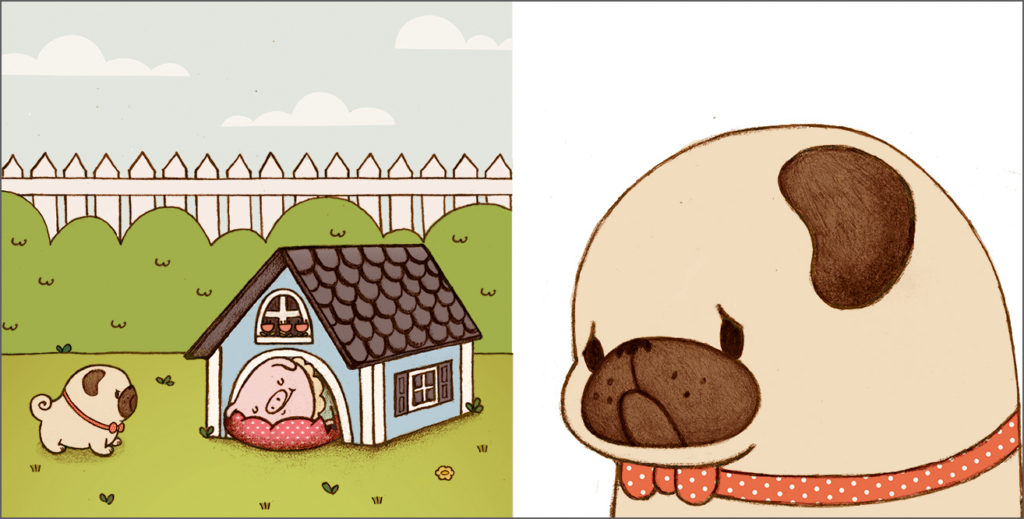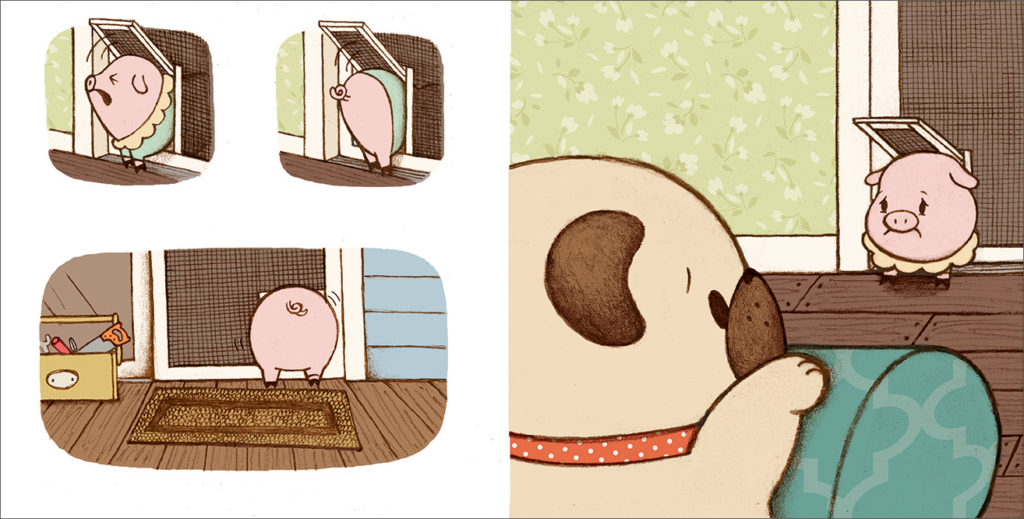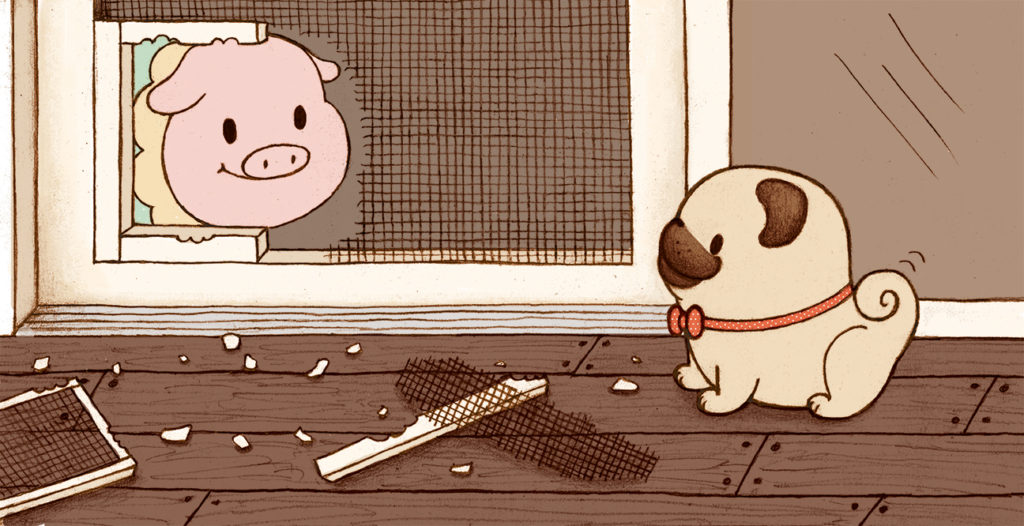My friend Sue Lowell Gallion’s first book, the warm and adorable PUG MEETS PIG (Beach Lane Books), entered the world last fall, and I thought it might be fun to talk about the book and interview Sue. What better time than Valentine’s Day to highlight a story in which two species become best pals?
In turn, Sue thought it might be fun to interview her book’s illustrator, Joyce Wan. Yippee! Two for one!

First, the publisher’s description of the book:
“An unlikely pair—a pug and a pig!—realize that it’s better to be together.
“Pug is a very happy pup. He has his own yard, his own bowl, and even his own cozy bed! That is, until Pig moves in and starts eating from Pug’s bowl, interrupting Pug’s routine, and, worst of all, sleeping in Pug’s bed. Will Pug and Pig ever learn to live together as friends?
“This sweet and silly story about a darling duo celebrates the timeless themes of embracing change, being kind to others, and finding friends in unlikely places.”

But here is Pig! Pug is not happy. He is not happy here at home anymore. Art ©Joyce Wan
What I love about the book is that Sue kept the text super simple. Pair that with the appealing, oversized illustrations by Joyce Wan, and you’ve got read aloud magic for group situations. And lap situations, too! Enjoy.
Jill: Tell us what sparked the idea that became PUG MEETS PIG.
Sue: A friend in my water aerobics class told me about a family with a pug named Charlotte, who adopted a rescue pig. They named him Wilbur. Every week, while we treaded water, we heard more tales of the pug and the pig. Unfortunately, Charlotte did not like Wilbur. The family eventually had to find Wilbur a new home. I thought a story about a pug and a pig needed a happy ending.
Jill: While writing this story, was a goal to keep it short (what WAS the final word count?) or did that happen while revising?
Sue: My first drafts of this story, in 2011, were written as an early reader so I used a controlled vocabulary. Those drafts were less than 150 words. As I revised the story over several years, it grew, and it seemed to work better as a picture book (and it had gotten a number of rejections as an early reader!) The manuscript I submitted for a manuscript critique at the SCBWI LA conference in 2013 was 350 words. The revised manuscript Beach Lane bought was 293 words.
The final version, though, is only 230 words. The original manuscript did have more repetition. And as Joyce Wan brought the story to life, some sentences and descriptions weren’t necessary any more, and slowed down the story. Andrea Welch, the editor, sent me sketch dummies several times during the process, and we talked through how to trim the text as well as word changes. For example, in the story, Pug “works” in his yard. The text originally had several more sentences that described Pug barking at blowing leaves, strolling people, and prowling cats. With the illustrations telling the story, those lines could be cut. So the length and the vocabulary work well as a beginning reader after all.
I think the editing process is magical. It was amazing watching the book evolve.
Jill: Since your lines (especially in the first part of the book) are amazingly spare, did you include any/many illustration notes?
Sue: Well, looking back, the early reader versions had more illustration notes than text! As the story evolved, I got rid of all the illustration notes, but the text was more explanatory.
I did put a three-sentence intro in italics that helped set up the story on the draft that I submitted for critique. That’s one work-around if you need to identify that your main character is an ostrich, or if the story won’t make sense unless you establish a certain setting. But I try to avoid illustration notes altogether if I can.
However, a caveat – since this book sold as a result of a manuscript critique, I also had a 20-minute one-on-one editorial conversation with Allyn Johnston, vice president and publisher, of Beach Lane Books. You don’t usually get a chance to talk through a manuscript you are hoping to sell with an editor! That’s one of the reasons why SCBWI regional or national conference manuscript critiques are so valuable.

Pig’s head can fit through the doggy door. Pig’s tail can fit through the doggy door. But Pig’s round middle cannot fit. What a sad Pig! Art ©Joyce Wan
Okay, now it’s Sue’s turn to interview illustrator Joyce. Take it away, Sue!
Sue Lowell Gallion: Joyce, would you walk us through your process in creating Pug and Pig’s world? What’s the backstory behind giving Pug a doghouse? It is quite a deluxe model with the window boxes and shutters.
Joyce Wan: I wanted to create a world that felt safe and cozy to go with the roly-poly, huggable characters in the story. The doghouse is a symbol of home. Pig sleeping in Pug’s doghouse meant Pug’s domain, as he knew it, was no more. It’s the last straw that breaks the camel’s back before Pug decides he must leave. Regarding the souped-up doghouse I also wanted to show that Pug was a pampered dog who was king of his castle and got everything he wanted.
Sue: What made you choose the color palette and textures you use in Pug Meets Pig?
Joyce: I tend to gravitate to a particular color palette in a lot of my work and they’re usually colors that are a little off from the traditional rainbow colors. So instead of straight red, green, blue and black, I’ll use colors such as blush pink, olive, teal, lime, and brown which you will see a lot of in Pug Meets Pig. The colors are soft and muted to go with that safe and cozy feeling that I wanted to establish.

[After Pug helps by scratching and gnawing, chewing and clawing…] And then the doggy door for Pug… …is also a piggy door for Pig! Art ©Joyce Wan
Joyce: The art in Pug Meets Pig was illustrated in pencil and colored in Photoshop. I appreciate simple design and clean lines, characters and objects that are stripped down to their purest form and art that is bold and iconic yet lovable. While working on this book, I would often draw the pug or pig face and body over and over again until I captured the right nuance of expression with the least amount of lines.
——————————–
Check out Sue’s website here. On her Resources page, you’ll find a dynamite Pug Meets Pig activity kit with a maze, pencil toppers, friendship bracelets, etc., free for the downloading. Kids will love it!
Want to win a copy of the book for your kiddos? Just leave a comment!
Thanks, Sue and Joyce, for stopping by PBB!

Great interview, Jill, Sue, and Joyce! Pug Meets Pig is such a great story, and the illustrations are delightful.
Thanks, Jody! Happy Valentine’s Day!
I loved hearing about how you each developed the story. I had no idea Pug Meets Pig started as an early reader!
Thanks, Traci! One of the reasons I love this blog/site is how it reveals a book’s backstory. They’re all different, aren’t they!
I LOVE Pug Meets Pig! Congratulations to Sue and Joyce, and thank you, Jill, for shining a light on this wonderful book!!!
I agree, this book works wonderfully as an early reader. My 5-year-old and I have had quite a few snuggle sessions with this one.
Love hearing that, Lindsay! I’m always on the hunt for picture books that are fun for early or reluctant readers. Jan Thomas and Greg Pizzoli’s picture books are some of my favorites for that. I’d love to hear other people’s suggestions, too.
You’re very welcome, Judy!
Thank you, Judy!
This book succeeds on so many levels–a friendship book, a problem-solving story, a story about acceptance, and a model for how children can solve problems on their own. I’ve had the privilege of reading and studying Sue’s followup book and families will clamor for that one as well.
Thanks, Ann! So grateful for my long-time critique partners! (Sending hugs to you and Jody Jensen Shaffer!)
Congratulations Sue & Joyce! Pug Meets Pig sounds delightful! I cannot wait to read it:)
Thanks, Sheri! Love our Kansas SCBWI crew.
So cute! Thanks for sharing! I love these interview posts!
Thanks, Katie — I’ve learned so much from this site, too!
I love, love, love learning how other people’s books came to be and the challenges in creating them. I feel like I learn something new every time.
Thank you, Jill–Such a great twofer interview with Sue and Joyce.
Since I love the delightful book A PUG MEETS PIG, I enjoyed reading all about the process Sue & Joyce used for writing and creating this story.
Thank you, Suzy!
Thanks for visiting, Suzy!
Cute book. I read Pug Meets Pig book during a storytime at the library and the kids (and parents) loved it. I’m looking forward to Pug & Pig Trick or Treat!
Delighted to hear that, Stacy. Thank you! Just wait till you see Joyce Wan-ized pumpkins and scarecrows . . .
Will be happy to share this with our patrons! Thanks for the link to Sue’s website. Will use the activity kit.
Thanks, Janet!
My daughter is a pug fanatic! Calendars, t-shirts, pajamas, posters, and so many stuffies! We will have to add PUG MEETS PIG to our collection 🙂
Hugs and pugs to you and your daughter, Lori!
This is so adorable!! Congrats, Sue & Joyce!!
Thanks so much, Maria!
What an adorable book! Thanks for sharing.
Thank you, Danielle!
Love this idea and the illustrations! Can’t wait to read it!
Thanks, Kim!
This looks totally adorable. Thanks for sharing, Jill, and congrats to Sue and Joyce!
Thank you, Linda!
Sue, you managed to get so much emotion and action in so few words — impressive! And it was interesting to hear how Joyce brought these two adorable character to life. Fun post!
Wouldn’t it be nice to have 20 minutes with an editor for every submission?? Thanks, Linda!
Cute story and great illustrations!
Thanks, Kathy. It’s been a dream come true to get to experience the text coming to life!
These characters look adorable! Perhaps I should get off the treadmill and try water aerobics . . .LOL. Congratulations Sue!
LOL! I’ve been out of the water for a while and need to get back to class!
Thanks, Wendy!
Pug and Pig are adorable! I especially liked hearing the editorial process of the book. Thanks, Sue and Joyce.
It was such a learning experience for me, Patricia. “Kill your darlings” isn’t the same when the visual story makes some text unnecessary, and the editors are so skilled at pacing.
Loved Sue’s comment “I think the editing process is magical. It was amazing watching the book evolve.” Thank you for the rare and valuable glimpse into the dance between text, illustration, author, artist and editor becomes a book!
Thanks, Cathy!
Adorable!
Thanks, Q!
So adorable! Thanks for sharing!
Pigtastic!
This article seems to bear the caption “less is more”. Thee is a simplicity to both the manuscript and the drawings which conveys such a power to bring home important messages with strong phrases and cozy images. Tending to always be too wordy in my PB manuscripts, this was good for me to read to be reminded of the richness of a smaller word count PB that conspires with the illustrations to create such a memorable book for listener/readers, and probably a book that really young children can learn to memorize, which is a great path to learning to read.
Jill, Sue, and Joyce, great double interview. Pug Meets Pig is a great mentor text on maximizing story with minimal text and leaving room for your collaborating illustrator.
Thanks, LeeAnn. I really liked Sue’s idea of the double interview. And what a fun story-behind-the-story – from both POVs!
So interesting to hear the evolution of the text. I love the illustrations too. It’s a lovely book to look out for. Thank you!
So cute! Those illustrations definitely convey emotions with simple lines. Wonderful! And I’m delighted to hear about the revision process too. Thanks for sharing.
This looks so fun. I’m loving the art!!
This book is adorable! I loved the interview. I’m currently trying to write a picture book manuscript for critique by an editor and am struggling with how much detail to put in the text. I have the story vision in my head, but anyone else would have a different version. Picture books are so much more diffficult to write than short stories. I appreciate the advice about illustration notes and how I need to let the pictures do most of the details for me.